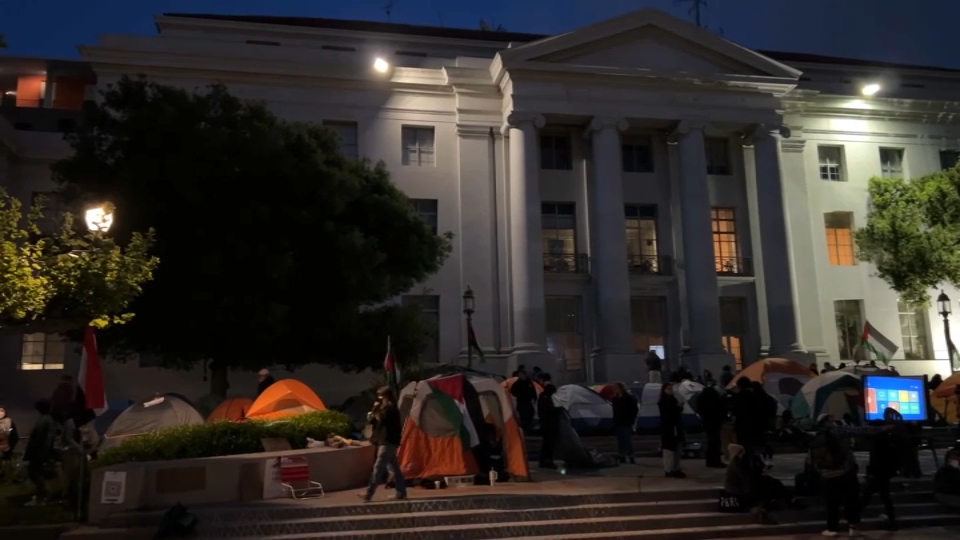California public schools are some of the most earthquake resistant schools in the world. But NBC Bay Area found decades of safety failures from non-structural items not properly attached to school buildings. Experts say some of them can pose a deadly threat to students and staff.
In the recent 6.0 Napa earthquake, school buildings held up fine. In fact, none of Napa Valley Unified’s schools suffered any structural damage. But there were dangerous breakdowns inside classrooms.
Photos taken by inspectors after the quake show a file cabinet collapsed on to desks, a drill press lying on the floor and toppled bookcases blocking exits.
“It was sobering to see so many furnishings unrestrained,” said structural engineer Maryann Phipps.
The failures in Napa weren’t unique - they’ve happened in previous earthquakes across California for decades.
Phipps is co-authoring a report on the Napa earthquake for FEMA, the Federal Emergency Management Agency. When she saw NBC Bay Area’s first story showing damage inside Napa schools, the photos concerned her so much she added a chapter on schools to her report.
“When we all look at those photographs we recognize that, you know, had it been another time of day it would have been a completely different story,” Phipps said. “And we would have been mourning the loss of students.”
Local
California is home to stringent school construction standards.
“They’re the envy of the world,” said Richard McCarthy, the executive director of the California Seismic Safety Commission. “I get many people who come in from around the world and ask why California schools do so well in earthquakes.”
[GALLERY]Earthquake Damage in California Public Schools
Seismic experts tell NBC Bay Area that schools have come a long way structurally thanks to the Field Act, a law put into place in 1933 after schools collapsed in the Long Beach Earthquake. But the act has little to say about the ongoing maintenance of non-structural elements like furniture and lighting.
“I don't know that all the non-structural hazards in classrooms have been evaluated and mitigated as well as the structural hazards have,” Phipps said. “While we’ve taken care of the serious structural concerns against collapse or partial collapse of our schools, I don't think we’ve given the same attention to all the non-structural hazards.”
Take, for example, pendant lights, light fixtures that hang from the ceiling.
NBC Bay Area first showed multiple failures of pendant lights in the Napa earthquake. The lights can be sharp and weigh up to 80 pounds.
Pendant lights failed in previous earthquakes, too. Lights fell inside school buildings in Calexico in 2010, Northridge in 1994, Coalinga in 1983 and Kern County in 1952. Those earthquakes all happened outside school hours.
“To be continuing to see those photographs and that kind of damage is a little disheartening, and a little shocking, and really unacceptable,” Phipps said.
With the exception of a 5.3 earthquake in Daly City in 1957, no significant earthquakes have happened during school hours since 1900.
The Division of the State Architect oversees construction of public K-12 schools and community colleges. DSA is responsible for the safety of pendant lights - but only when a school is built or remodeled. Some schools may not have had a DSA review in years or even decades.
Another danger is the contents of classrooms. Displaced furniture, shelves and shop equipment show up again and again in photos taken inside schools after major earthquakes.
“I seriously don’t think the public understands what moves around in a building, the contents, how that can move,” McCarthy said. “They’re like huge missiles in the air or just giant objects falling down.”
Multiple state agencies have warned about the dangers posed by unrestrained classroom contents since as early as 1971.
“I think some of the items are relatively easily fixed at a very low cost,” said Napa Fire Marshal Darren Drake.
Furniture that falls and blocks classroom exits is of particular concern.
“One of the things that often happens with earthquakes is gas lines get damaged and that could lead to a fire emergency,” said Contra Costa Fire Marshal Robert Marshall.
Marshall said students and staff must have a free and clear path out of the building once the shaking stops.
When shown photos of blocked exits, Marshall said, “The exiting issue is really concerning because I don’t think most people are going to be able to get out of something like that very easily.”
School districts are responsible for furniture and securing contents inside a classroom. NBC Bay Area asked the California Department of Education for an on camera interview. They declined, writing in an email, “We would certainly respond to your request if we were the regulating agency in this instance, but we are not.”
However, there is no agency which regulates classroom furniture.
When an earthquake shook Calexico four years ago, the undersides of outdoor overhangs, called soffits, fell. “That's incredibly dangerous,” Phipps said. “I mean if anybody had been standing under this it would've been obviously been very seriously injured.”
One of the fallen soffits sheared off doorknobs and blocked classroom doors.
“That was a very bad incident,” McCarthy said. “That was a scary incident.”
Soffits are a non-structural component of a building under the jurisdiction of the Division of the State Architect, but only at the time of construction and during renovations. The school where they fell, Jefferson Elementary School, was built in 1968.
New construction is safer.
“How much of this is still out there, is harder to say,” said Phipps.
“And again, that was not during school hours,” Phipps added. “That was when there were no students there. So the fact that every time, I mean, one of these times it's not going to happen in the middle of the night.”
And that’s a scenario that has a lot of people worried, and wondering if more can be done to keep kids safe.
“We’re going to be tested here pretty soon I’m sure with a big event,” McCarthy said.



